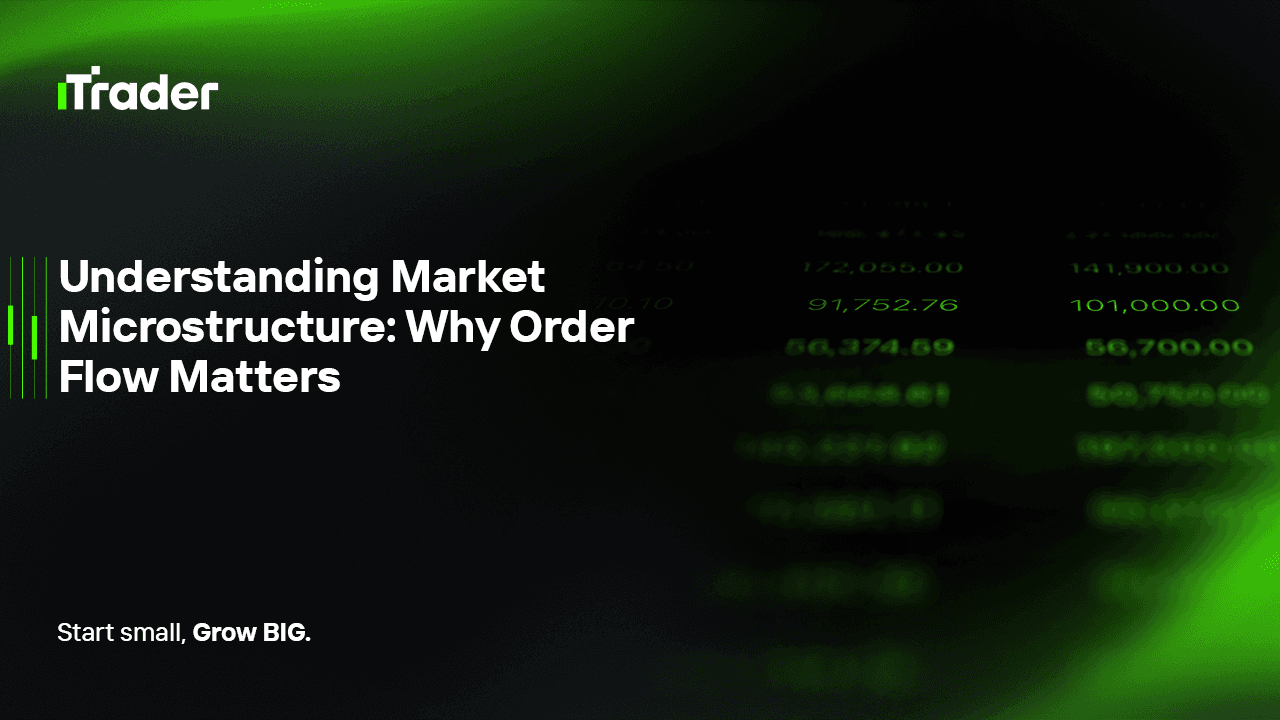2025-07-02
To the average trader, markets appear as a stream of prices moving up and down. But what causes those movements? What drives that next tick in the price of EUR/USD or S&P 500 futures?
The answer lies not in broad economic theory, but in the microstructure of the market—the mechanics that govern how orders are matched, how liquidity forms, and how information becomes priced in. At the center of this machinery is order flow: the detailed record of how buyers and sellers interact.

Understanding market microstructure and tracking order flow can provide traders with insights that traditional technical indicators simply cannot. Whether you’re trading manually or building an automated strategy, mastering this layer of market behavior is essential for precision and performance.
AI Summary:
What is market microstructure and why does order flow matter?
Market microstructure is the study of how financial markets operate at the transaction level, focusing on the mechanics behind trade execution, order types, liquidity, and price formation. Order flow refers to the real-time sequence of buy and sell orders and is a critical factor in understanding short-term price movements. By analyzing order flow, traders can identify institutional activity, assess market sentiment, and improve trade timing and execution. Understanding microstructure helps traders reduce slippage, interpret price action more effectively, and gain an edge in high-frequency or algorithmic trading strategies.
Market microstructure is the study of the processes and protocols through which trades are executed. It focuses on the real-time behavior of market participants and the infrastructure that facilitates price discovery.
Unlike macroeconomics, which asks why prices move, microstructure asks how they move—from the smallest change in a limit order book to the impact of execution speed.
Order flow is the net movement of buy and sell orders across the market. It reflects real-time sentiment and reveals which side—buyers or sellers—is more aggressive.
Every time a trade occurs, it represents a market order "hitting" a limit order resting in the book. For instance:
A consistent flow of aggressive buying or selling can push price in that direction—even without new information entering the market.
To understand microstructure, it’s essential to identify who’s placing the orders and why. Participants are not all equal—they have different motives, speeds, and strategies.
They provide liquidity by quoting both buy and sell prices, profiting from the bid-ask spread. They aim for frequent, low-risk trades.
These include hedge funds, mutual funds, and pension funds. They often split large orders into smaller chunks to avoid moving the market—a tactic called order slicing or iceberging.
Typically trade smaller sizes. Their impact on order flow is limited but can become significant in thin or fast markets.
HFT firms thrive on speed and microstructure inefficiencies. They use co-location and low-latency algorithms to anticipate short-term price shifts.
Price doesn't move just because of news or fundamentals—it moves when orders are executed. If buyers are more aggressive than sellers (i.e., market orders are lifting the ask), the price moves up.
This is why volume alone isn't enough—you must know whether the volume was executed on the bid or the ask. That directional intent is what gives order flow its predictive power.
Understanding microstructure and order flow can transform how you approach the market.
Rather than relying on lagging indicators, traders can observe real-time buyer/seller aggression to enter on confirmation, not prediction.
Watching where large passive orders rest in the book (and where they disappear) can reveal hidden support/resistance levels.
Unusual surges in one-sided order flow, iceberg orders, or spoofing patterns often hint at large player involvement.
Quantitative strategies that integrate order book dynamics and trade prints often outperform those based solely on price and volume.
These tools help traders make informed decisions in fast-moving markets, where milliseconds matter.
Many modern trading strategies—especially in prop trading firms—are built on microstructure principles.
While powerful, interpreting order flow isn’t without challenges:
As markets evolve, so do microstructure dynamics. Increasing automation, fragmentation (across multiple venues), and the rise of crypto markets are reshaping how order flow is interpreted.
New frontiers include:
For traders and firms that adapt, microstructure offers one of the clearest competitive advantages in the market.
In trading, timing is everything—and timing depends on structure. While most strategies operate at the macro or technical analysis level, it’s the microstructure that determines the fine print of success.
Order flow analysis gives traders the ability to see beneath the surface of candles and indicators, revealing the intent behind every price movement. By learning to read the market’s internal language, traders gain sharper entries, smarter exits, and the capacity to compete in the most data-driven segment of the financial world.
Whether you're developing an algorithm, executing manually, or running a prop desk, understanding market microstructure is no longer optional—it's foundational.
© 2025 iTrader Global Limited|会社登録番号:15962
iTrader Global Limitedは、コモロ連合のアンジュアン自治島ムツァムドゥのHamchakoに所在し、コモロ証券委員会によって認可・規制を受けています。ライセンス番号は L15962/ITGL です。
iTrader Global Limitedは「iTrader」の商号で運営しており、外国為替取引業務を行う許可を受けています。会社のロゴ、商標、ウェブサイトはすべて iTrader Global Limited の専有財産です。
iTrader Global Limitedの他の子会社には、iTrader Global Pty Ltd(オーストラリア会社登録番号(ACN):686 857 198)が含まれます。 この会社は、Opheleo Holdings Pty Ltd(オーストラリア金融サービスライセンス(AFSL)番号:000224485)の認可を受けた代表者(AFS代表番号:001315037)です。登録住所は Level 1, 256 Rundle St, Adelaide, SA 5000 です。
免責事項: この法人は、本ウェブサイト上で取引される金融商品の発行者ではなく、それらに対して責任を負いません。
リスク警告: 差金決済取引(CFD)は、レバレッジにより資本の急速な損失リスクが高く、すべての利用者に適しているとは限りません。
ファンド、CFD、その他の高レバレッジ商品を取引するには、専門的な知識が必要です。
調査によると、84.01%のレバレッジ取引者が損失を被っています。取引を開始する前に、リスクを十分に理解し、資金を失う可能性があることを認識してください。
iTraderは、レバレッジ取引によるリスク、損失、またはその他の損害について、個人または法人に対して一切の責任を負わないことを明言します。
利用制限: iTraderは、法律、規制、または政策によりこのような活動が禁止されている国の居住者を対象として、本ウェブサイトやサービスを提供していません。